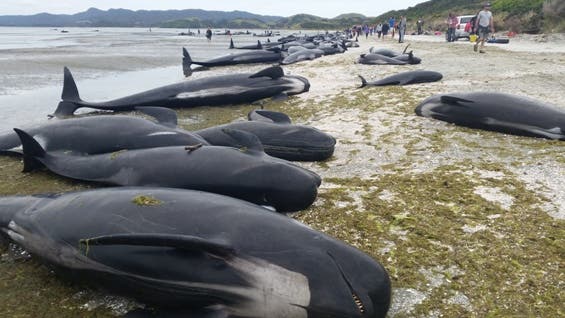It is a daunting sight. Hundreds of whales, crying, sighing, and some of them already rotting lay stranded on the beach. In one of the worst whale strandings in history, hundreds of farmers, tourists and teenagers were racing to save the whales, but 275 of the pilot whales didn’t even survive until they arrived. It’s one of the most frantic rescue operations we’ve ever seen.

Magazine editor Cheree Morrison and photographer Jane Ussher raced out to see what was happening, and they report a disaster.
“It was just red and pink skies and just whales as far as you could see,” Morrison said. “It was really haunting.” At that moment, people didn’t really know what was happening and the story was still unfolding. “Your first instinct was to run to them and help in any way possible,” she said, but they were only three people, completely unprepared.
“There’s nothing you can do,” the guide, who notified authorities, told them.
Official government sources claim that 100 whales were refloated, but there is very little good news. New Zealand’s Department of Conservation staged a massive rescue mission, aided by locals, but success rate was not that high.
“Around 416 pilot whales stranded near the base of Farewell Spit overnight, of which 250 to 300 were already dead when the whales were discovered,” the report states. “A refloat of over 100 whales took place on the high tide around 10.30 am Friday morning. The refloat has been partially successful with around 50 whales out swimming in the bay. The remaining 80 to 90 have re-stranded on the beach.”
“The beached whales will be keep comfortable with the help of volunteers until dark.”
It’s not clear what the chances of the remaining whales are, but it doesn’t look too good. Rescuing whales is a very delicate and even dangerous job, as stressed whales can easily injure humans. They can also carry diseases to volunteers are asked to avoid bodily fluids from whales and avoid getting cuts.
In the meantime, darkness has set in New Zealand, and locals were asked to go home for the night and return in the morning… if any living whales are still left.
“There will be no work done overnight as it would become unsafe for people to be close to the whales in the dark. If necessary, a second attempt to refloat the stranded whales will take place tomorrow around noon on the high tide.”
Every year, up to 2,000 animals beach themselves. About 10 cetacean species frequently display mass beachings, with 10 more rarely doing so. Pilot whales are among those more likely to get stranded.


